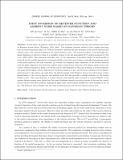Joint inversion of receiver function and ambient noise based on Bayesian theory
Author(s)
Liu, Qi-Yuan; Yu, Li; Chen, Jiu-Hui; Guo, Biao; Wang, Jun; Qi, Shao-Hua; Li, Shun-Cheng; van der Hilst, Robert D; ... Show more Show less
Downloadvan der Hilst_Joint inversion.pdf (6.344Mb)
PUBLISHER_POLICY
Publisher Policy
Article is made available in accordance with the publisher's policy and may be subject to US copyright law. Please refer to the publisher's site for terms of use.
Terms of use
Metadata
Show full item recordAbstract
In this study, we present a method for the joint inversion of receiver function and ambient noise based on Bayesian inverse theory (Tarantola, 1987, 2005). The nonlinear inversion method of the complex spectrum ratio of receiver functions (Liu et al., 1996) is extended to perform the joint inversion of the receiver function and ambient noise with a global scanning of the crustal Poisson’s ratio. The forward problem of the Rayleigh-wave phase dispersion is solved in terms of a modified version of the fast generalized R/T method proposed by Pei et al. (2008, 2009). Our numerical tests show that (1) the dependency of inversion results on initial models is removed and the model’s parameter is estimated reliably even in the case of using a vertically homogeneous model as the initial guess for the crust structure; (2) because the frequency band consistency of the receiver function with the phase dispersion obtained from ambient noise is much better than that with seismic surface waves, the
S-wave velocity structure in depth of 0~80 km can be well estimated by the joint inversion of receiver function and noise-derived phase velocity dispersion in the period range of 2~40 s, and the space resolution of the shallow structure near to the surface can reach 1 km; (3) global scanning of the Poisson’s ratio is not only in favor of data
interpretation of the receiver function and ambient noise, but also provides a reliable estimation of the crustal Poisson’s ratio. The joint inversion of receiver function and ambient noise recorded at station KWC05 of the western Sichuan seismic array shows that the crustal thickness beneath the station reaches 44 km and the crustal S-wave velocity structure manifests a high-speed upper crust and low-speed middle-lower crust in depth of 24~42 km. The Poisson’s ratio averaged over the crust is 0.262 and that over the low-velocity zone is 0.27.
Date issued
2010-11Department
Massachusetts Institute of Technology. Department of Earth, Atmospheric, and Planetary SciencesJournal
Chinese Journal of Geophysics
Publisher
Chinese Geophysical Society (CGS)
Citation
Liu, Qi-Yuan et al. "Joint inversion of receiver function and ambient noise based on Bayesian theory." Chinese Journal of Geophysics 53.6 (2010): 240-251. © 2010 by the Chinese Geophysical Society.
Version: Final published version
ISSN
0898-9591